2020 MERCEDES-BENZ CLA wheel
[x] Cancel search: wheelPage 149 of 570
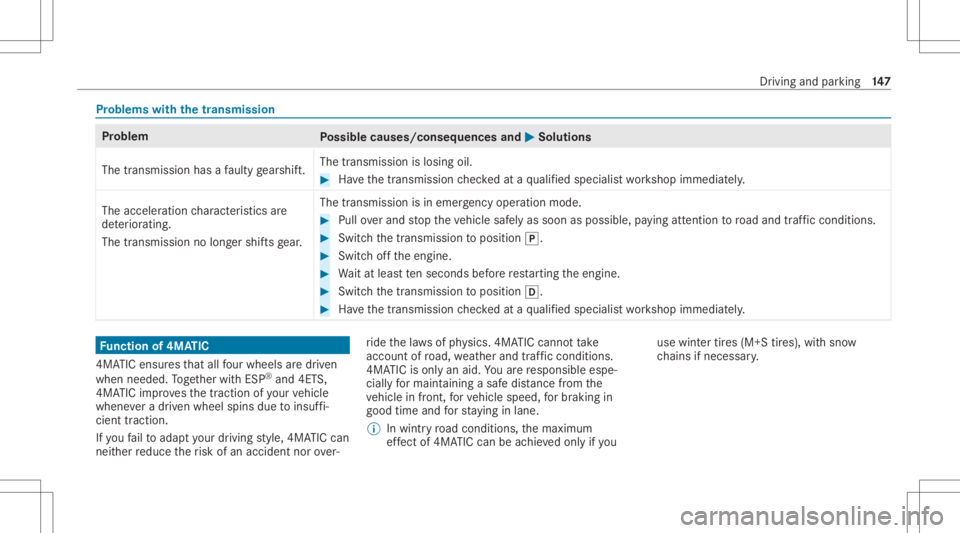
Pr
oblems withthetransm ission Pr
oblem
Possible causes/conseq uencesand0050 0050
Solutions
The transmission hasafa ulty gearshif t. The
transm issionis losin goil. #
Have thetra nsmiss ioncheckedat aqu alif ied spec ialistwo rkshop immediat ely.
The acceler ationcharact eristic sar e
de terior ating.
The transmission nolong ershif tsgear. The
transm issionis in emer gency operati on mod e. #
Pullove rand stop theve hicle safely assoon aspossible, paying attention toroad and traf fic condi tions. #
Swi tchth etra nsmiss iontoposition 005D. #
Switc hof fth eengine. #
Waitat leas tte nseco ndsbefore restar tin gth eengine. #
Switc hth etra nsmiss iontoposition 005B. #
Have thetra nsmiss ioncheckedat aqu alif ied spec ialistwo rkshop immediat ely. Fu
nction of4MA TIC
4MA TICensur esthat all four wheel sar edr iven
when needed. Toget her withESP ®
and 4ETS,
4MA TICimprove sth etra ction ofyour vehicle
whene vera dr iven whee lspins duetoinsuf fi‐
cie nttracti on.
If yo ufa ilto adap tyo ur drivin gst yle, 4MA TICcan
neit her reduce therisk ofan accident norover‐ ri
de thelaws ofphysics. 4MA TICcannotta ke
acc oun tof road, weather and traf fic condi tions.
4MA TICisonly anaid. Youar ere sponsible espe‐
cially formaint ainingasaf edis tance from the
ve hicle infront, forve hicle speed, forbr aking in
good timeandforst ay ing inlane.
% Inwint ryroad con dition s,themaximum
ef fect of 4MA TICcan beachie vedonl yif yo u use
wint ertires (M+ Stir es), withsn ow
ch ains ifnec essar y. Dr
iving and parking 14
7
Page 152 of 570
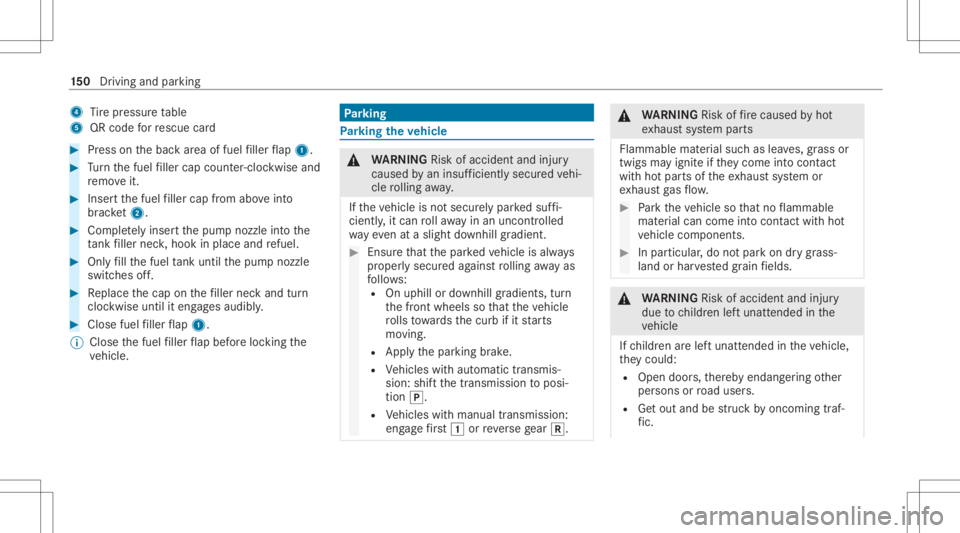
4
Tire pressur eta ble
5 QRcode forre scue card #
Press onthebac kar ea offuel filler flap 1. #
Turn thefuel filler cap coun ter-cloc kwiseand
re mo veit. #
Insertth efuel filler cap from aboveinto
br ac ket2. #
Comp lete ly inse rtthepum pnoz zleintoth e
ta nk filler neck,hook inplace andrefuel . #
Onlyfill th efuel tank unti lth epum pnoz zle
switc hesoff. #
Replace thecap onthefiller neckand turn
cloc kwise untilit eng ages audibl y. #
Close fuelfiller flap 1.
% Close thefuel filler flap bef oreloc kin gth e
ve hicle. Pa
rking Pa
rking theve hicl e &
WARNIN GRisk ofacci dent andinjury
cau sed byan insufficie ntlysecu redve hi‐
cle rolling away.
If th eve hicle isno tsecur elyparkedsuf fi‐
cie ntly ,it can rollaw ay inan unc ontrolled
wa yev en ataslight downhill gradient. #
Ensur eth at thepar kedve hicle isalw ays
pr oper lysecur edagains tro lling away as
fo llo ws :
R Onuphil lor downhill gradients, turn
th efront wheels sothat theve hicle
ro lls towa rdsth ecurb ifit star ts
mo ving.
R App lythepar king brak e.
R Vehicles withaut omatic transmis‐
sion: shiftth etransmission toposi‐
tion 005D.
R Vehicles withmanual transmission:
eng agefirs t0047 orreve rsege ar 005E. &
WARNIN GRisk offire cau sed byhot
ex haus tsy stem parts
Flammable material suc has lea ves, grass or
twigs mayignit eif th ey come intocont act
wi th hotpar tsof theex haus tsy stem or
ex haus tga sflow . #
Park theve hicle sothat no flammab le
mat erial can com eint ocon tact with hot
ve hicle component s. #
Inpar ticular ,do notpar kon drygr ass‐
land orhar vested grain fields. &
WARNIN GRisk ofacci dent andinjury
due tochildr enleftunat tende din the
ve hicle
If ch ildr enarelef tunat tende din theve hicle,
th ey cou ld:
R Ope ndoo rs,th er eb yendang ering other
per sons orroad user s.
R Getout and bestru ck byoncom ingtraf‐
fi c. 15
0
Driving and parking
Page 153 of 570

R
Oper ateve hicle equipment andbecome
tr apped, forex am ple.
In addit ion,th ech ildr encould alsosetth e
ve hicle inmo tion, forex am ple by:
R Releasing thepar king brak e.
R Changing thetra nsmiss ionposition .
R Startin gth eve hicle. #
Neverlea vechildr enunat tende din the
ve hicle. #
When leaving theve hicle, alwaysta ke
th eke ywit hyo uand lockth eve hicle. #
Keep theve hicle keyout ofreac hof
ch ildr en. *
NO
TEDama getotheve hicle duetoit
ro lling away #
Alw ayssecur eth eve hicle agains tro ll‐
ing away. #
Bring theve hicle toast ands tillby appl ying
th ebr ak epedal. #
Onuphill ordownhill gradients, turnth efront
wheels sothat theve hicle rolls towa rdsth e
curb ifit star ts mo ving. #
App lytheelectr icpar king brak e. #
Vehicl eswith automatic transmiss ion:
Eng agetransmis sionposition 005Dinast atio n‐ ar
yve hicle withth ebr ak epedal applied
(/ page14 3). #
Switc hof fth eengine andtheignition by
pr essing button1. #
Release theser vice brak eslo wly. #
Getout oftheve hicle andlockit.
% When youpar kth eve hicle, youcan still
opera tetheside windo wsand thepanor amic
sliding sunroofforapp roxima tely five
minut esifth edr iver's door isclosed. Gar
agedoor opener Pr
og rammin gbutt onsfo rthe garage doo r
ope ner &
DANG ER Risk ofdeat hcause dby
ex haus tga ses
Combus tionengines emitpoisonous exhaus t
ga ses suchas carbon monoxide.Inhaling
th ese exhaus tga ses ishazar dous tohealt h
and leads topoisonin g. Dr
iving andparking 15
1
Page 163 of 570
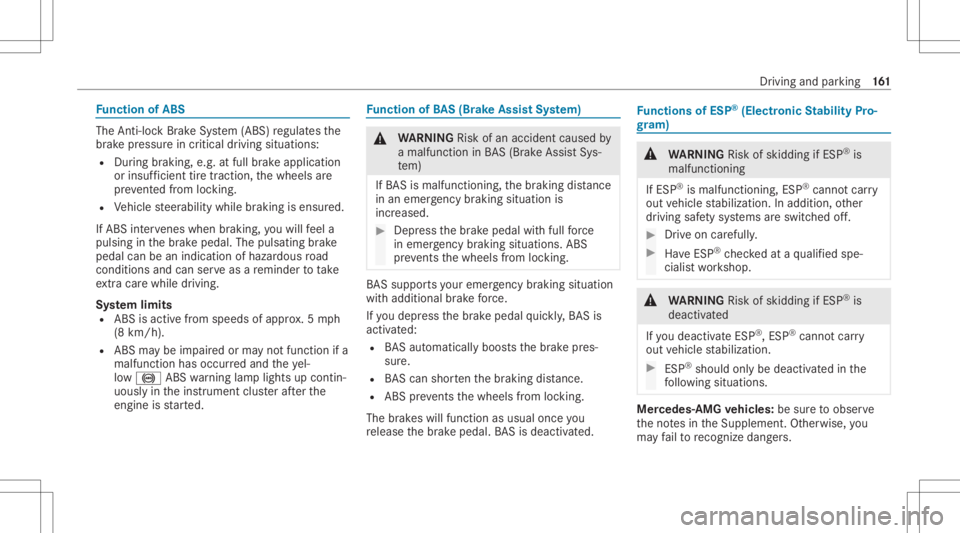
Fu
nction ofABS The
Anti-loc kBr ak eSy stem (ABS )re gulat esthe
br ak epr essur ein critical driving situation s:
R Dur ing braking, e.g.atfull brak eapplication
or insuf ficie nttiretracti on, thewheels are
pr eve nted from lock ing.
R Vehicle steer ability whilebraking isensur ed.
If ABS interve nes when braki ng, youwill feel a
pulsing inthebr ak epedal. Thepulsating brak e
pedal canbeanindicat ionofhazar dous road
con dition sand canserveas are minder totake
ex tra car ewh ile dr ivi ng.
Sy stem limit s
R ABSis act ive from speeds ofappr ox.5 mp h
(8 km/ h).
R ABSma ybe impair edorma yno tfunc tion ifa
malfunc tionhasoccurredand theye l‐
lo w 0025 ABSwa rning lam plight sup con tin‐
uousl yin theins trument clusteraf te rth e
engine isstar ted. Fu
nction ofBA S(Br akeAssis tSy stem) &
WARNIN GRisk ofan acci dent caused by
a malf unctionin BA S(Br akeAssi stSys‐
te m)
If BA Sis mal functi oning,th ebr aking distance
in an eme rgency braki ng situa tionis
incr eased . #
Dep ress thebr ak epedal withfull forc e
in emer gency braki ng situa tions. ABS
pr eve nts thewheels from locking . BA
Ssu ppo rts yo ur eme rgency braking situation
wit hadditional brak efo rc e.
If yo udepr essthebr ak epedal quickl y, BA Sis
acti vated:
R BASau tomatical lyboos tsthebr ak epr es‐
sur e.
R BAScan shorten thebr aking distance.
R ABS preve nts thewheels from locking .
The brak es will func tion asusual onceyo u
re lease thebr ak epedal. BASis dea ctivated. Fu
nctions ofESP ®
(Electr onicStabil ityPro‐
gr am) &
WARNIN GRisk ofskid ding ifESP ®
is
mal functi oning
If ESP ®
is mal functi oning,ESP ®
canno tcar ry
out vehicle stabiliz ation.Inaddit ion,ot her
dr iving safetysy stems areswitc hedoff. #
Drive on car efull y. #
Have ESP ®
ch eckedat aqu alif ied spe‐
cialis two rkshop. &
WARNIN GRisk ofskid ding ifESP ®
is
dea ctivated
If yo udeac tivateES P®
,ES P®
can notcar ry
out vehicle stabiliz ation. #
ESP®
shoul don lybe deactiv ated inthe
fo llo wing situat ions. Mer
cedes‑AM Gve hicl es:besur eto obser ve
th eno tesin theSupplement .Ot her wise, you
ma yfa ilto recogni zedangers. Dr
iving and parking 16
1
Page 164 of 570
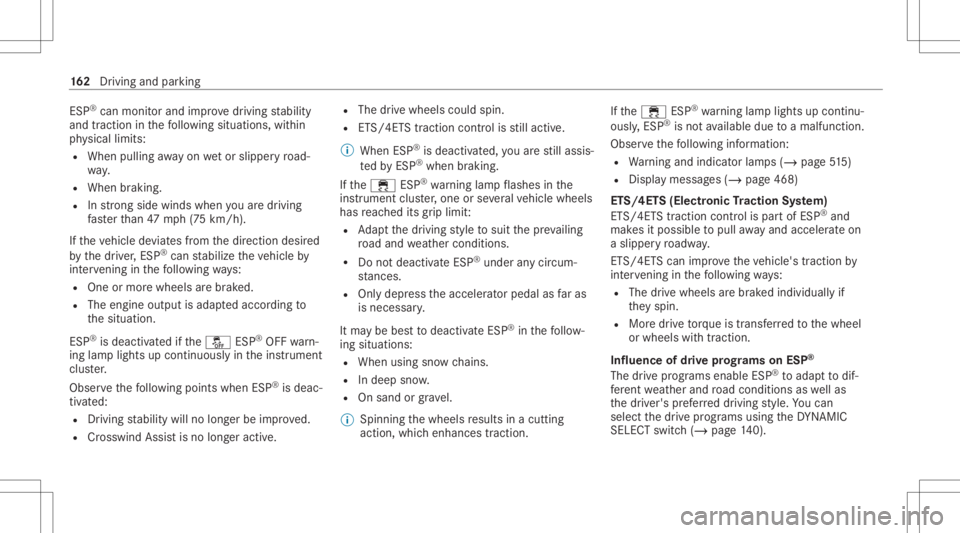
ESP
®
can moni torand improve driving stabilit y
and tract ion inthefo llo wing situat ions,wit hin
ph ysical limit s:
R When pulling away on wetor slip pe ry road‐
wa y.
R When braking.
R Instro ng side winds when youar edr ivin g
fa ster than 47 mp h(7 5 km/h).
If th eve hicle deviat esfrom thedir ect ion desir ed
by thedr iver ,ES P®
can stabiliz eth eve hicle by
int erve ning inthefo llo wing ways:
R One ormor ewheels arebr ak ed.
R The engine outputisadap tedaccor dingto
th esituation .
ES P®
is deactiv ated ifth e00BB ESP®
OFF warn‐
ing lam plight sup con tinuousl yin theins trument
clus ter.
Obser vethefo llo wing pointswhen ESP®
is deac‐
tiv ated:
R Drivin gst abilit ywill nolongerbe improve d.
R Crosswind Assistis no long eractiv e. R
The drive wheels couldspin.
R ETS/4 ETStra ction control isstill act ive.
% When ESP®
is deact ivat ed, youar est ill assis‐
te dby ESP ®
wh en braki ng.
If th e00E5 ESP®
wa rning lam pflashes inthe
ins trumen tclus ter,one orseveralve hicle wheels
has reac hed itsgrip limit :
R Adaptth edr iving style to suit thepr ev ailin g
ro ad and weather condition s.
R Donotdeac tivateES P®
unde ran ycir cum ‐
st anc es.
R Onlydepr esstheacceler ator pedal asfaras
is necessar y.
It ma ybe bes tto deactiv ateES P®
in thefo llo w‐
ing situat ions:
R When usingsnowch ains .
R Indeep snow .
R Onsand orgrave l.
% Spin ningth ewheels results inacutting
action, whichenhances traction. If
th e00E5 ESP®
wa rning lam plight sup con tinu‐
ousl y,ESP ®
is no tav ailable duetoamalf unction.
Obse rveth efo llo wing informatio n:
R Warning and indic ator lam ps(/ page51 5)
R Displ aymessa ges(/ page468)
ET S/4ET S(Ele ctronic Tractio nSy stem)
ET S/ 4ETS tracti oncontr olispa rtof ESP ®
and
mak esitpossible topull away and accelerat eon
a slippe ryroadw ay.
ET S/4ET Scan improve theve hicle's traction by
int erve ning inthefo llo wing ways:
R The drive wheels arebr ak ed individually if
th ey spin.
R Mor edr ive to rq ue istrans ferred tothewheel
or wheels withtraction .
Influenc eof drive pr og rams onESP®
The drive pr ogr amsena ble ESP ®
to adap tto dif‐
fe re nt we ather and road con dition sas wellas
th edr iver's prefer reddr iving style. Youcan
sele ctthedr ive pr og rams using theDY NA MIC
SELE CTswitc h(/ page14 0). 16
2
Driving and parking
Page 166 of 570
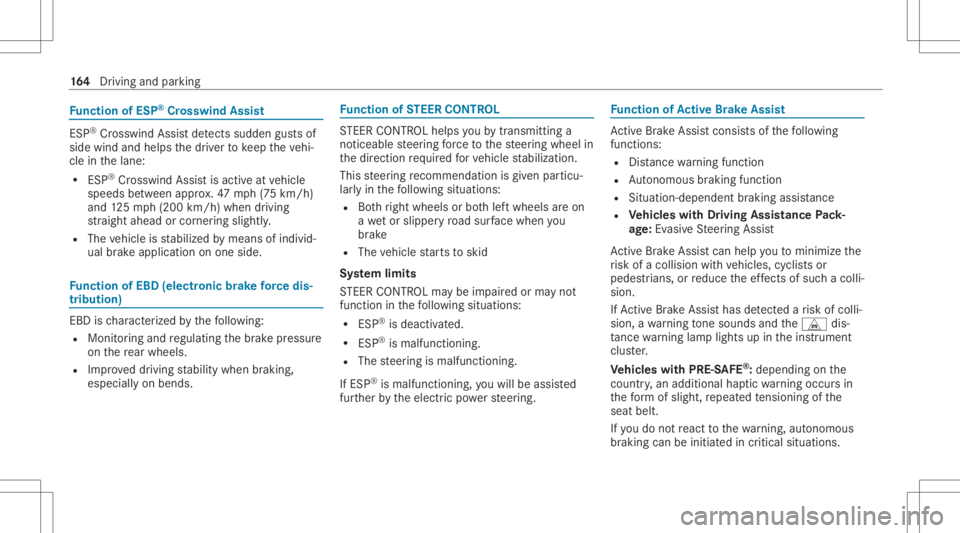
Fu
nction ofESP ®
Cr osswind Assist ES
P®
Cr osswind Assistde tects sudde ngu stsof
side wind andhelps thedr iver tokeep theve hi‐
cle inthelane:
R ESP®
Cr osswind Assistis activ eat vehicle
speeds between appr ox.47 mp h(7 5 km/h)
and 125mp h(200 km/h) whendriving
st ra ight ahead orcor ner ing slight ly.
R The vehicle isstabiliz edbymeans ofindivi d‐
ua lbr ak eapp lication onone side. Fu
nction ofEBD (electr onicbrak efo rc edis‐
tr ibut ion) EB
Dis ch aract erize dby thefo llo wing:
R Mon itor ing and regulating thebr ak epr essur e
on there ar wheels .
R Improve ddr iving stabilit ywhen brakin g,
espe ciallyon ben ds. Fu
nction ofSTEER CONT ROL ST
EER CONTR OLhelpsyo uby trans mitting a
no tice ablesteer ing forc eto thesteer ing wheel in
th edir ect ion requ ired forve hicle stabiliz ation.
This steer ing recomme ndation isgiv en particu‐
lar lyin thefo llo wing situat ions:
R Both right wheels orboth leftwheels areon
a we tor slip pe ry road sur face whe nyo u
br ak e
R The vehicle star ts to skid
Sy stem limit s
ST EER CONTR OLmaybe impai redor ma yno t
func tion inthefo llo wing situat ions:
R ESP®
is deact ivat ed.
R ESP®
is malfun ctionin g.
R The steer ing ismalfunct ioning.
If ES P®
is malfunct ioning,youwill beassis ted
fur ther by theelectr icpo we rst eer ing. Fu
nction ofActiv eBr ak eAs sist Ac
tiveBr ak eAssi stconsi stsof thefo llo wing
func tions:
R Distance warning func tion
R Autonomo usbraki ng func tion
R Situ ation-d epend ent braki ng assist anc e
R Vehicl eswith Drivin gAss istanc ePa ck‐
ag e:Evasi ve Steer ing Assis t
Ac tiveBr ak eAssi stcan helpyo uto minimize the
ri sk ofacollision withve hicles, cyclis tsor
pedes trians, orreduce theef fects ofsuch acol li‐
sion .
If Ac tiveBr ak eAssi sthas detected arisk ofcolli‐
sion, awa rning tone sou nds and theL dis‐
ta nce warning lam plight sup intheins trument
clus ter.
Ve hicl eswith PRE-S AFE®
:depe nding onthe
cou ntry,an addit ionalhap ticwarning occursin
th efo rm ofslight, repeat edtensi oni ng ofthe
seat belt.
If yo udo notre act tothewa rning, autono mous
br akin gcan beinit iated incritic alsituat ions. 16
4
Driving and parking
Page 172 of 570
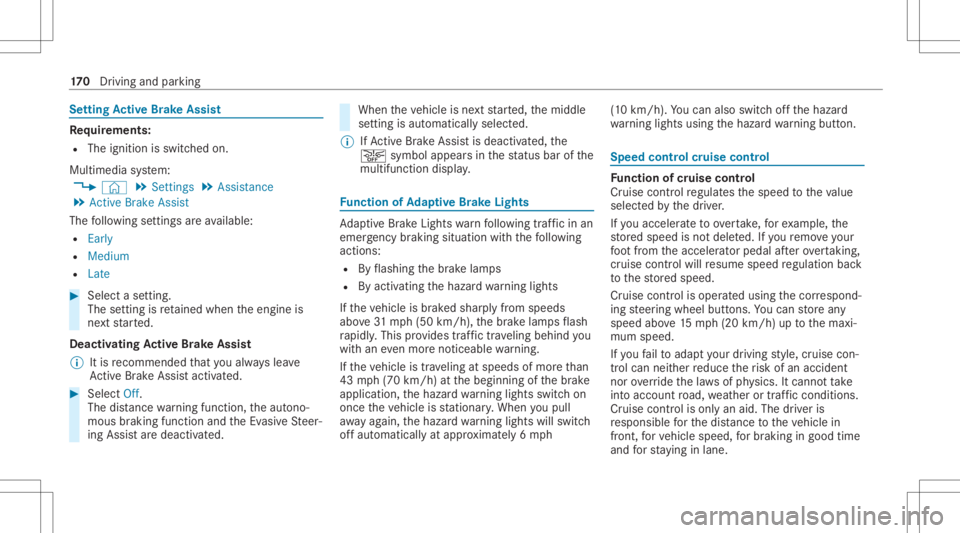
Se
tting Activ eBr ak eAs sist Re
quirement s:
R The ignit ionisswitc hedon.
Multime diasystem:
4 © 5
Set ting s5
Assist ance
5 Act ive Brak eAssist
The follo wing settings areav ailable:
R Early
R Medium
R Late #
Select ase tting .
The setting isretained when theengine is
ne xt star ted.
Deactiv atingActiv eBr ak eAs sist
% Itis recomme ndedthat youalw ayslea ve
Ac tiveBr ak eAssi stact ivat ed. #
Select Off.
The distance warning func tion,th eaut ono‐
mous braking function andtheEv asiv eSt eer‐
ing Assis tar edeactiv ated. When
theve hicle isne xt star ted, themiddle
se tting isaut omaticall yselect ed.
% IfAc tiveBr ak eAssi stisdeact ivat ed, the
00D4 symbol appearsinthest atus barofthe
multifu nctiondisplay. Fu
nction ofAd aptiv eBr ak eLig hts Ad
aptiveBr ak eLigh tswa rnfollo wing traffic in an
eme rgency braki ng situ ation with thefo llo wing
act ions :
R Byflashin gth ebr ak elam ps
R Byactiv ating thehazar dwa rning light s
If th eve hicle isbrak ed shar plyfrom speeds
abo ve31 mp h(50 km/h), thebr ak elam psflash
ra pidl y.This prov ides traf fic trave ling behin dyo u
wit han even mor eno ticeable warning.
If th eve hicle istrav eling atspeeds ofmor eth an
43 mph(70 km/h) atthebeginnin gof thebr ak e
application, thehazar dwa rning light sswitc hon
onc eth eve hicle isstatio nary.When youpull
aw ay again, thehazar dwa rning light swill switc h
of faut omat icallyat appr oximat ely6 mp h (1
0 km/ h).Youcan also switchoffth ehazar d
wa rning light susing thehazar dwa rning butt on. Speed
controlcruise contr ol Fu
nction ofcruise contr ol
Cr uise controlre gulat esthespeed totheva lue
selec tedby thedr iver .
If yo uacc eler ateto ove rtak e, forex am ple, the
st or ed speed isno tdele ted. Ifyo ure mo veyour
fo ot from theaccelera torpeda laf te rov ertaking ,
cr uise contr olwillre sume speed regulation back
to thestor ed speed.
Cr uise controlis opera tedusing thecor respond‐
ing steer ing wheel buttons. Youcan stor ean y
speed above15 mp h(20 km/h) uptothemaxi‐
mum speed.
If yo ufa ilto adap tyo ur drivin gst yle, cruise con‐
tr ol can neither reduce therisk ofan accident
nor override thelaws ofphysics. Itcan notta ke
int oacc ount road, weather ortraf fic condi tions.
Cr uise contr olisonly anaid. The driver is
re sponsible forth edis tance totheve hicle in
fr ont, forve hicle speed, forbr aking ingood time
and forst ay ing inlane. 17
0
Driving and parking
Page 173 of 570
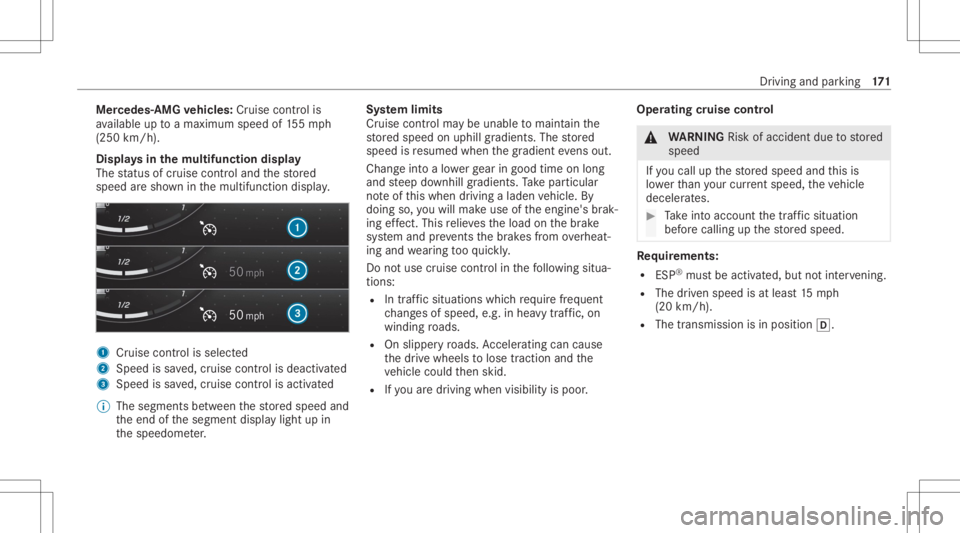
Mer
cede s‑AMG vehicl es:Cruis econtr olis
av ailable uptoamax imum speedof 155mp h
(250 km/h).
Displa ysinthemu ltifunct iondisp lay
The status ofcruise control and thestor ed
speed aresho wninthemultifunc tiondispla y. 1
Cruise contro lis selec ted
2 Spee dis save d, cruise control isdeactiv ated
3 Speed issave d, cruise control isactiv ated
% The segmen tsbetween thestor ed speed and
th eend ofthesegment displaylight upin
th espeedome ter. Sy
stem limit s
Cr uise control ma ybe unable tomaint ainthe
st or ed speed onuphill gradients. Thestor ed
speed isresumed whenthegr adient evensout.
Ch ang eint oalowe rge ar ingood timeon long
and steep downhill gradients. Take par ticular
no te ofthis when drivin galaden vehicle. By
doing so,youwill mak euse oftheengine' sbr ak‐
ing effect. Thisre lie vesth eload onthebr ak e
sy stem and preve nts thebr ak es from overheat‐
ing and wearing tooqu ickl y.
Do notus ecr uise contr olinthefo llo wing situa‐
tion s:
R Intraf fic situ ations whichrequ ire freq uent
ch ang esofspee d,e.g .in hea vytraf fic, on
wi nding roads.
R Onslippe ryroads. Accel erati ng can cause
th edr ive wheels tolose tract ion and the
ve hicle could then skid.
R Ifyo uar edr ivin gwhen visibilit yis poor . Ope
ratin gcr uis eco ntr ol &
WARNIN GRisk ofacci dent dueto stor ed
speed
If yo ucall upthestor ed speed andthis is
lo we rth an your cur rent spe ed,th eve hicle
deceler ates. #
Take intoacc ount thetra ffic situat ion
bef orecallin gup thestor ed speed. Re
quirement s:
R ESP®
mus tbe act ivat ed, but notint erve ning .
R The driven spe edisat leas t15 mp h
(20 km/ h).
R The transmis sionisin positio n005B. Dr
iving andparking 17
1